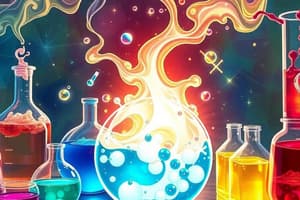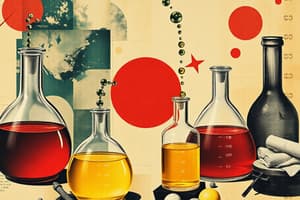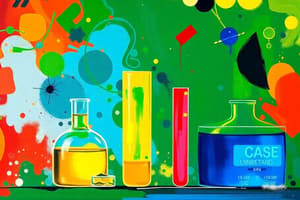Podcast
Questions and Answers
What characteristic taste do acids have?
What characteristic taste do acids have?
- Bitter taste
- Sweet taste
- Sour taste (correct)
- Salty taste
Which of the following is a common acid used in various applications?
Which of the following is a common acid used in various applications?
- Butyric acid
- Ascorbic acid
- Salicylic acid
- Acetic acid (correct)
What happens when an acid reacts with a metal carbonate?
What happens when an acid reacts with a metal carbonate?
- It produces salt, carbon dioxide, and water. (correct)
- It produces only a metal salt.
- It produces only carbon dioxide.
- It produces only water.
Which fruit is known for containing citric acid?
Which fruit is known for containing citric acid?
What color change does blue litmus paper undergo when exposed to an acid?
What color change does blue litmus paper undergo when exposed to an acid?
What gas is confirmed by bringing a burning splinter near a soap bubble filled with H2 gas?
What gas is confirmed by bringing a burning splinter near a soap bubble filled with H2 gas?
Which acid is found in vinegar?
Which acid is found in vinegar?
What happens to lime water when CO2 gas is passed through it?
What happens to lime water when CO2 gas is passed through it?
What are substances that change their colour or odour when added to an acid or alkaline solution called?
What are substances that change their colour or odour when added to an acid or alkaline solution called?
Which of the following is an example of a natural indicator?
Which of the following is an example of a natural indicator?
What colour does litmus paper turn when it is in an acidic medium?
What colour does litmus paper turn when it is in an acidic medium?
What type of indicator is prepared in the laboratory and is not derived from natural sources?
What type of indicator is prepared in the laboratory and is not derived from natural sources?
In which type of indicator does the colour change depend on the strength of the acid or base?
In which type of indicator does the colour change depend on the strength of the acid or base?
What do olfactory indicators do in an acidic or basic medium?
What do olfactory indicators do in an acidic or basic medium?
What does the strength of an acid or base depend on?
What does the strength of an acid or base depend on?
What color does phenolphthalein turn in a basic solution?
What color does phenolphthalein turn in a basic solution?
What is the outcome of diluting an acid with water?
What is the outcome of diluting an acid with water?
What happens when water is added to a concentrated acid?
What happens when water is added to a concentrated acid?
Which ion is produced by all acids in the presence of water?
Which ion is produced by all acids in the presence of water?
What is the general outcome of the neutralization reaction between an acid and a base?
What is the general outcome of the neutralization reaction between an acid and a base?
Which of the following is formed when sodium hydroxide reacts with hydrochloric acid?
Which of the following is formed when sodium hydroxide reacts with hydrochloric acid?
Which type of reaction occurs when an acid neutralizes a base?
Which type of reaction occurs when an acid neutralizes a base?
What do all bases produce when dissolved in water?
What do all bases produce when dissolved in water?
Why shouldn't bases be stored in active metal containers?
Why shouldn't bases be stored in active metal containers?
What is injected into the skin during an ant sting?
What is injected into the skin during an ant sting?
Which indicator turns pink in a basic solution?
Which indicator turns pink in a basic solution?
What is the chemical formula of common salt?
What is the chemical formula of common salt?
What is the pH value of salts formed by a strong acid and strong base?
What is the pH value of salts formed by a strong acid and strong base?
What is produced in the chlor-alkali process apart from sodium hydroxide?
What is produced in the chlor-alkali process apart from sodium hydroxide?
Which plant's leaves help alleviate pain caused by nettle stings?
Which plant's leaves help alleviate pain caused by nettle stings?
What type of acid is present in the stomach?
What type of acid is present in the stomach?
What pH range does the human body typically operate within?
What pH range does the human body typically operate within?
What is the main product formed when plaster of Paris is mixed with water?
What is the main product formed when plaster of Paris is mixed with water?
Which substance is obtained when gypsum is heated above 400 K?
Which substance is obtained when gypsum is heated above 400 K?
What is the function of the water of crystallisation in hydrated salts?
What is the function of the water of crystallisation in hydrated salts?
How does heating affect hydrated salts?
How does heating affect hydrated salts?
What is one of the primary uses of plaster of Paris?
What is one of the primary uses of plaster of Paris?
What happens to copper sulfate when it is heated?
What happens to copper sulfate when it is heated?
Which of the following describes Plaster of Paris correctly?
Which of the following describes Plaster of Paris correctly?
What is the color of anhydrous copper sulfate?
What is the color of anhydrous copper sulfate?
What reaction occurs when sodium hydrogen carbonate is heated or mixed with water?
What reaction occurs when sodium hydrogen carbonate is heated or mixed with water?
Which of the following is a use of sodium hydrogen carbonate?
Which of the following is a use of sodium hydrogen carbonate?
What is the chemical formula for washing soda?
What is the chemical formula for washing soda?
What property of sodium carbonate solution in water can be observed?
What property of sodium carbonate solution in water can be observed?
What happens to gypsum when it's heated at 373 K?
What happens to gypsum when it's heated at 373 K?
Which of the following is NOT a use of sodium carbonate?
Which of the following is NOT a use of sodium carbonate?
What is a common application of sodium hydrogen carbonate in baking?
What is a common application of sodium hydrogen carbonate in baking?
What is the primary effect of sodium hydrogen carbonate when used as an antacid?
What is the primary effect of sodium hydrogen carbonate when used as an antacid?
Flashcards
Acids
Acids
Chemical substances that taste sour and turn blue litmus paper red.
Hydrochloric Acid
Hydrochloric Acid
A common acid, often represented as HCl.
Acid reaction with carbonates
Acid reaction with carbonates
Produces salt, water, and carbon dioxide gas.
Carbon Dioxide Test
Carbon Dioxide Test
Signup and view all the flashcards
Metal Carbonate
Metal Carbonate
Signup and view all the flashcards
Test for hydrogen gas
Test for hydrogen gas
Signup and view all the flashcards
Effervescence
Effervescence
Signup and view all the flashcards
Natural Acids
Natural Acids
Signup and view all the flashcards
Dilution of acids/bases
Dilution of acids/bases
Signup and view all the flashcards
Acid effect in water
Acid effect in water
Signup and view all the flashcards
Base effect in water
Base effect in water
Signup and view all the flashcards
Acid-base neutralization
Acid-base neutralization
Signup and view all the flashcards
Dilution procedure
Dilution procedure
Signup and view all the flashcards
Neutralization reaction
Neutralization reaction
Signup and view all the flashcards
Hydronium ion formation
Hydronium ion formation
Signup and view all the flashcards
Base Formula
Base Formula
Signup and view all the flashcards
Acidic Indicators
Acidic Indicators
Signup and view all the flashcards
Alkaline Indicators
Alkaline Indicators
Signup and view all the flashcards
Natural Indicator
Natural Indicator
Signup and view all the flashcards
Synthetic Indicator
Synthetic Indicator
Signup and view all the flashcards
Universal Indicator
Universal Indicator
Signup and view all the flashcards
Olfactory Indicator
Olfactory Indicator
Signup and view all the flashcards
Acid Strength
Acid Strength
Signup and view all the flashcards
Base Strength
Base Strength
Signup and view all the flashcards
Common salt
Common salt
Signup and view all the flashcards
Caustic soda
Caustic soda
Signup and view all the flashcards
pH of 7
pH of 7
Signup and view all the flashcards
Acidic salt
Acidic salt
Signup and view all the flashcards
Basic salt
Basic salt
Signup and view all the flashcards
Chlor-alkali process
Chlor-alkali process
Signup and view all the flashcards
pH indicator
pH indicator
Signup and view all the flashcards
Baking Soda's Role
Baking Soda's Role
Signup and view all the flashcards
Baking Soda's Other Uses
Baking Soda's Other Uses
Signup and view all the flashcards
What is Washing Soda?
What is Washing Soda?
Signup and view all the flashcards
Washing Soda's Properties
Washing Soda's Properties
Signup and view all the flashcards
How is Washing Soda Made?
How is Washing Soda Made?
Signup and view all the flashcards
Uses of Washing Soda
Uses of Washing Soda
Signup and view all the flashcards
Plaster of Paris: The Formula
Plaster of Paris: The Formula
Signup and view all the flashcards
Making Plaster of Paris
Making Plaster of Paris
Signup and view all the flashcards
Plaster of Paris
Plaster of Paris
Signup and view all the flashcards
Gypsum
Gypsum
Signup and view all the flashcards
How does Plaster of Paris harden?
How does Plaster of Paris harden?
Signup and view all the flashcards
Water of Crystallisation
Water of Crystallisation
Signup and view all the flashcards
Hydrated Salts
Hydrated Salts
Signup and view all the flashcards
Anhydrous Salts
Anhydrous Salts
Signup and view all the flashcards
Dead Burn Plaster
Dead Burn Plaster
Signup and view all the flashcards
What happens when you heat hydrated salts?
What happens when you heat hydrated salts?
Signup and view all the flashcards
Study Notes
Acids, Bases and Salts
- Acids have a sour taste and turn blue litmus red
- Common fruits like unripe mangoes, lemons, oranges, and tamarinds are sour, indicating the presence of acids
- Examples of acids: hydrochloric acid (HCl), sulfuric acid (H₂SO₄), nitric acid (HNO₃)
- Naturally occurring acids: vinegar (acetic acid), orange/lemon (citric acid), tamarind (tartaric acid), tomato (oxalic acid), curd (lactic acid)
Test for Hydrogen Gas
- Pass the gas through a soap solution
- Bring a burning splinter near the soap bubble
- If the gas burns with a pop sound, it's hydrogen gas
Reaction of Acids with Metal Carbonates/Metal Hydrogen Carbonates
- Produces a salt, water, and carbon dioxide gas (effervescence)
- Example: Calcium carbonate + Hydrochloric acid → Calcium chloride + Water + Carbon dioxide
Reaction of Acids with Metals
- Dilute HCl and H₂SO₄ react with some active metals (zinc, iron, etc.)
- Forms a salt and releases hydrogen gas
- Acids should not be stored in metal containers
Test for Carbon Dioxide Gas
- Pass CO₂ gas through limewater
- Turns the limewater milky (precipitate of CaCO₃)
- Further CO₂ produces a soluble calcium bicarbonate, clearing the milkiness; excess CO₂ clears it
Bases
- Bitter taste, soapy touch, turn red litmus blue
- Examples: sodium hydroxide (NaOH), calcium hydroxide (Ca(OH)₂)
- Strong bases react with active metals to produce hydrogen gas
Reactions of Bases with Non-Metallic Oxides
- Produce a salt and water
- Non-metallic oxides are acidic, so bases neutralize them
Acids and Bases in Water
- Acids in water release H⁺ ions/H₃O⁺ (hydronium) ions
- Bases in water release OH⁻ ions
- Both conduct electricity because of ions
Effect of Dilution on Acids/Bases
- Diluting with water is exothermic (heat-generating)
- Always add acid to water, stir slowly
- Avoid adding water to a concentrated acid (heat generated may cause splashes)
Reaction of Acid with Base
- Produces salt and water
- Known as neutralization reaction
Indicators
- Substances that change color to indicate an acid or base
- Natural indicators (litmus, turmeric, red cabbage juice)
- Synthetic indicators (phenolphthalein, methyl orange)
pH Scale
- Measures hydrogen ion concentration
- Ranges from 0 (very acidic) to 14 (very alkaline)
- 7 is neutral
- Higher the H₃O⁺ concentration, the lower the pH value
Importance of pH
- Living organisms thrive in a narrow pH range
- Affects plant growth, digestive system, soil, teeth health
Common Salts
- Sodium Chloride (NaCl): table salt, from sea water
- Magnesium Hydroxide (Mg(OH)₂): antacids
Bleaching Powder (CaOCl₂)
- Used in textile industry, paper, bleaching clothes
- Prepared by reacting chlorine with slaked lime
Baking Soda (NaHCO₃)
- Used in baking, antacids, and fire extinguishers
- Formed by reacting sodium chloride, water, carbon dioxide, and ammonia
Washing Soda (Na₂CO₃·10H₂O)
- Used in glass, soap, paper, removes hard water
- Prepared by heating baking soda
- Hard water contains large amounts of calcium and magnesium ions
Plaster of Paris (CaSO₄·½H₂O)
- Used in plastering, models, fractured bones
- Prepared by heating gypsum (CaSO₄·2H₂O)
Water of Crystallization
- Water molecules in crystals of salts
- Heating removes water of crystallization (changes from hydrated to anhydrous form)
Studying That Suits You
Use AI to generate personalized quizzes and flashcards to suit your learning preferences.




